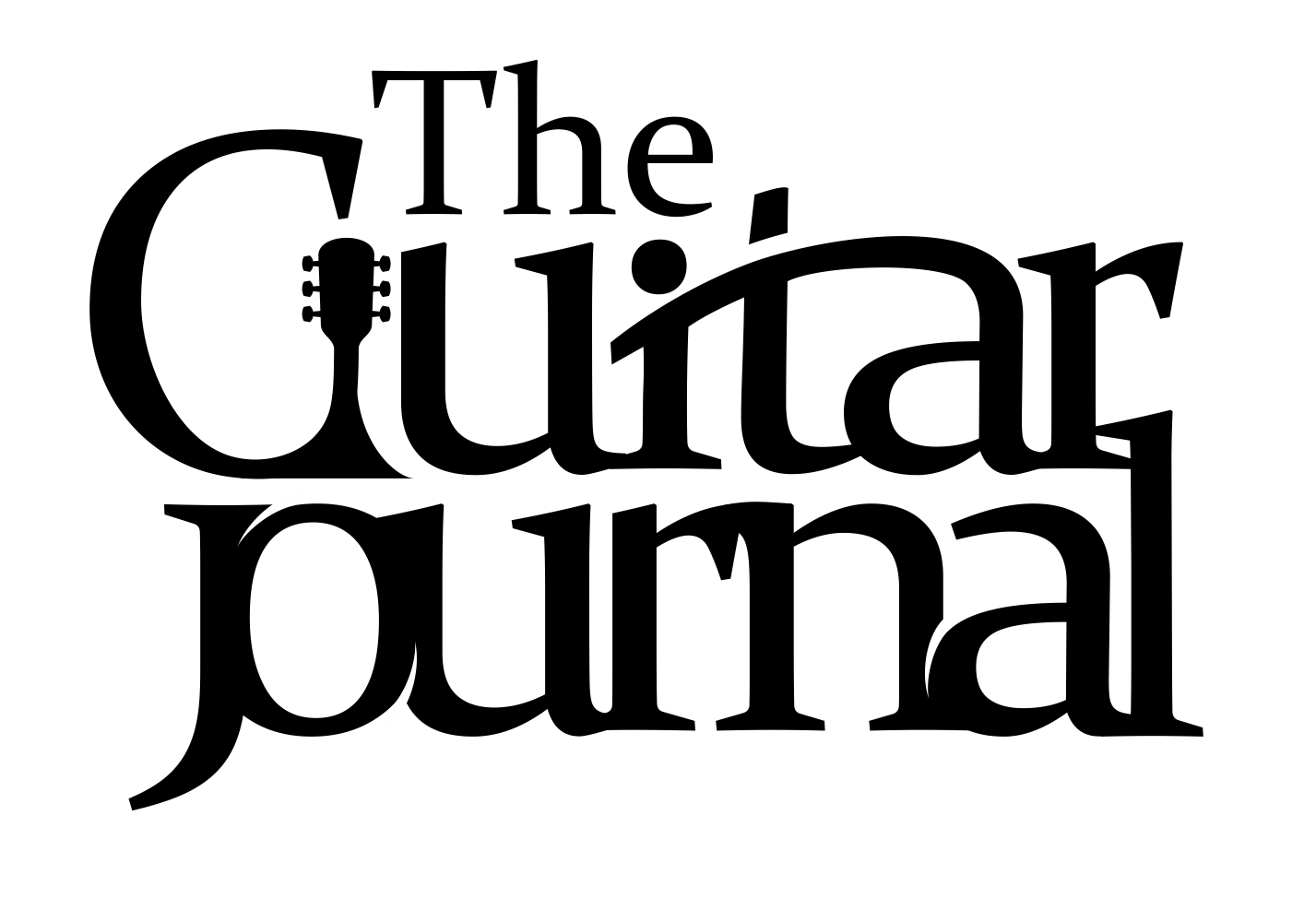Top 10 Best Jazz Guitars of All Time
Which jazz guitar is right for you? Whether you’re an intermediate jazz guitarist searching for your next upgrade or a vintage gear collector chasing that classic tone, we’ve got you covered. The world of jazz guitars is full of legendary instruments – from elegant archtops that defined the bebop era to unexpected solid-bodies that can swing with the best. In this guide, we’ll walk through 10 of the best jazz guitars of all time. We’ll highlight what makes each guitar special, who made them famous, and why they might belong in your collection (or on your wish list!). Let’s dive in:
1. Gibson ES-175 – The Classic Archtop Sound
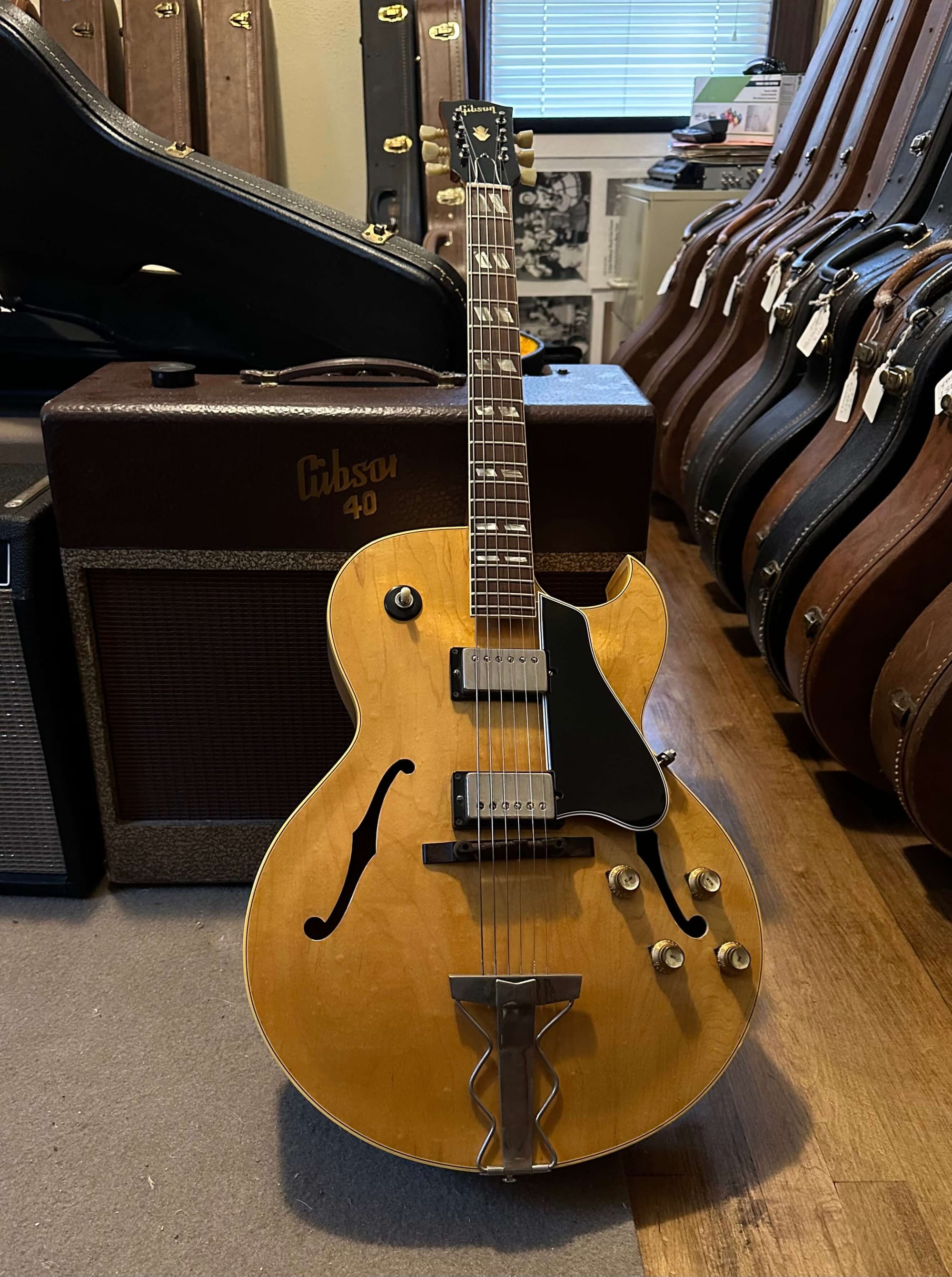
Why it’s iconic
The Gibson ES-175 is arguably the most famous jazz guitar ever made. Introduced in 1949, this hollow-body archtop has a warm, mellow tone that became the sound of jazz guitar for decades. Players like Joe Pass and Wes Montgomery swore by the ES-175’s rich chords and responsive feel.
In action
If you’ve ever listened to Joe Pass’s fluid solos or Wes Montgomery’s smooth octaves, you’ve heard the ES-175 in its full glory. It’s a guitar that “plays itself,” often described as very forgiving and soulful.
Great for
Intermediate players will appreciate the ES-175’s easy playability – the neck is comfortable, and the notes bloom nicely for both rhythm and solos. Collectors love this model for its history; original vintage models are highly sought after (and can be pricey). Thankfully, Gibson and even Epiphone have produced reissues, so you can find an ES-175 experience at various price points.
2. Gibson L-5 – High-End Elegance
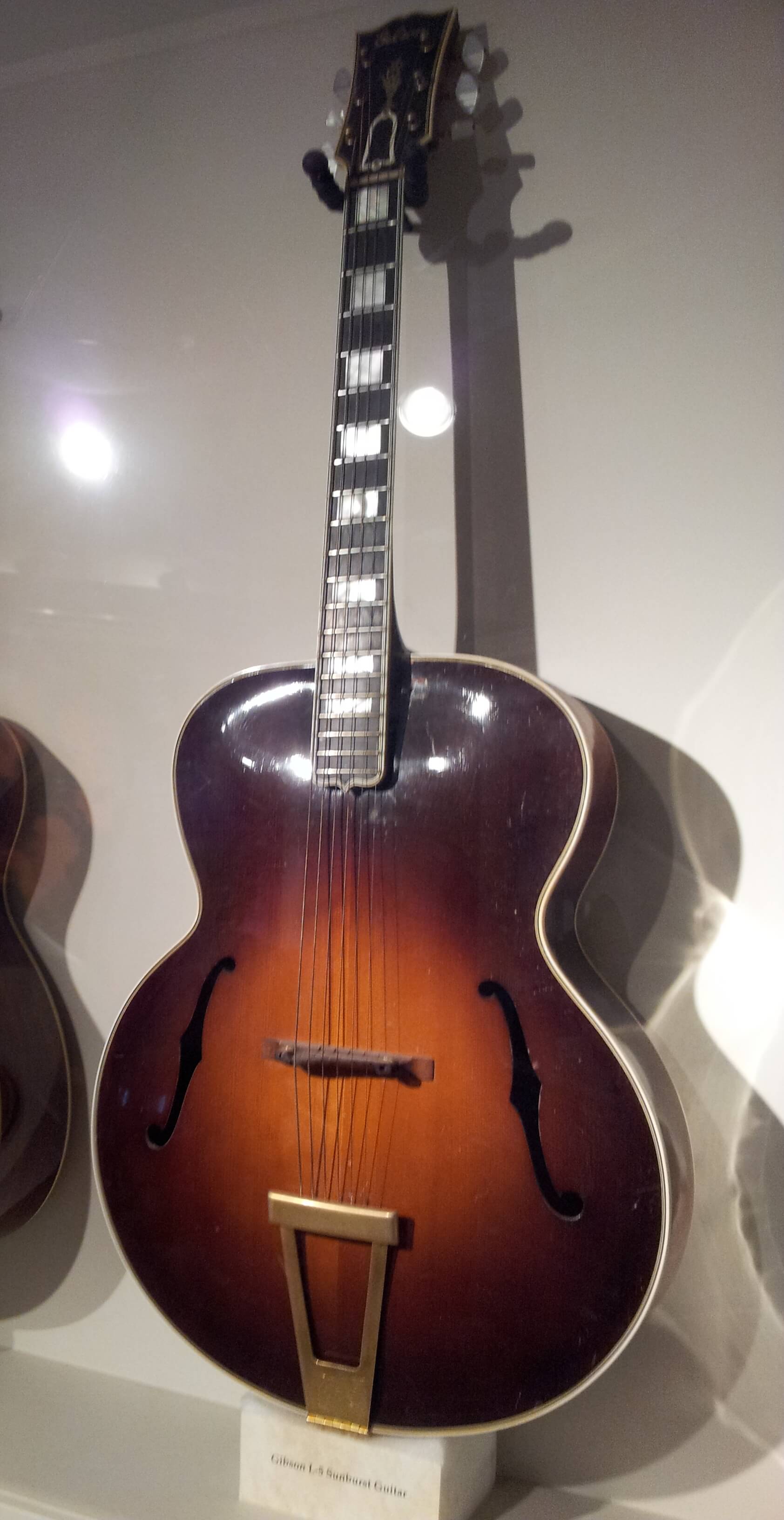
Why it’s iconic
The Gibson L-5 has been around since the 1920s and was one of the first “luxury” archtop guitars. It has a deep, rich tone and impeccable craftsmanship – carved spruce top, maple back and sides, gorgeous finishes. Jazz legends like Charlie Christian and Johnny Smith made the L-5 their weapon of choice, and even today it remains a status symbol for jazz guitarists.
In action
The L-5 delivers a punchy acoustic projection and warm electric tone. If you listen to early electric jazz guitar recordings (think Charlie Christian with Benny Goodman), that clear yet warm sound is the L-5 cutting through. It’s equally at home chunking out big band rhythm or singing on a ballad melody.
Great for
This guitar is for the serious enthusiast – whether a pro player or a collector. As an intermediate player, you might not drop five figures on a Gibson L-5 right now, but it’s something to aspire to. If you ever get to play one, you’ll notice the notes have a certain fullness and the guitar just resonates in your hands. For those on a budget, note that companies like Eastman or Ibanez offer instruments inspired by the L-5’s design at a fraction of the cost, so you can chase that tone without remortgaging your house!
3. D’Angelico Excel – Artistry in a Guitar
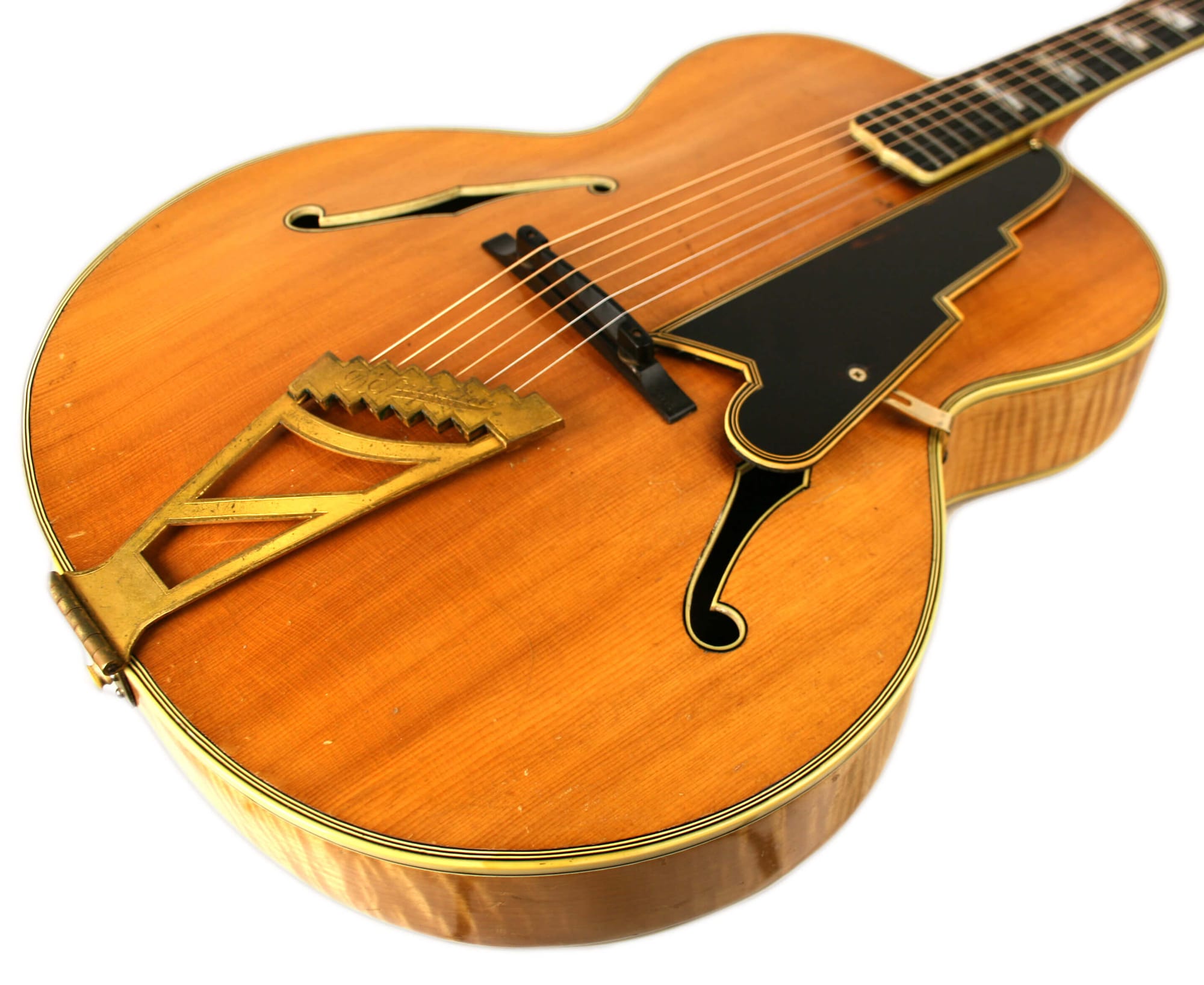
Why it’s iconic
Hand-built by luthier John D’Angelico in mid-20th century New York, original D’Angelico archtops are legendary. The Excel model, in particular, showcases intricate mother-of-pearl inlays, a distinctive headstock, and superb jazz tone. Jim Hall and Kenny Burrell – two giants of jazz guitar – have been known to play D’Angelico guitars, appreciating their blend of artistry and sound.
In action
A D’Angelico Excel doesn’t just look stunning; it sounds buttery smooth. The chords have a piano-like clarity, and the single-note lines float with a warm, rounded character. It’s the kind of guitar that makes you want to comp bossa nova chords all night or play a silky-smooth chord-melody arrangement.
Great for
This is a guitar for the connoisseurs. If you’re a collector, an original D’Angelico is a crown jewel (and priced like one). For working musicians or intermediate players, modern D’Angelico-branded Excel reissues exist, offering that old-school vibe with modern reliability. It’s perfect for those who value the aesthetic as much as the tone – you’ll feel like you’re holding a piece of jazz history when you play it.
4. Benedetto Bambino – Modern Jazz Box for the Gigging Musician
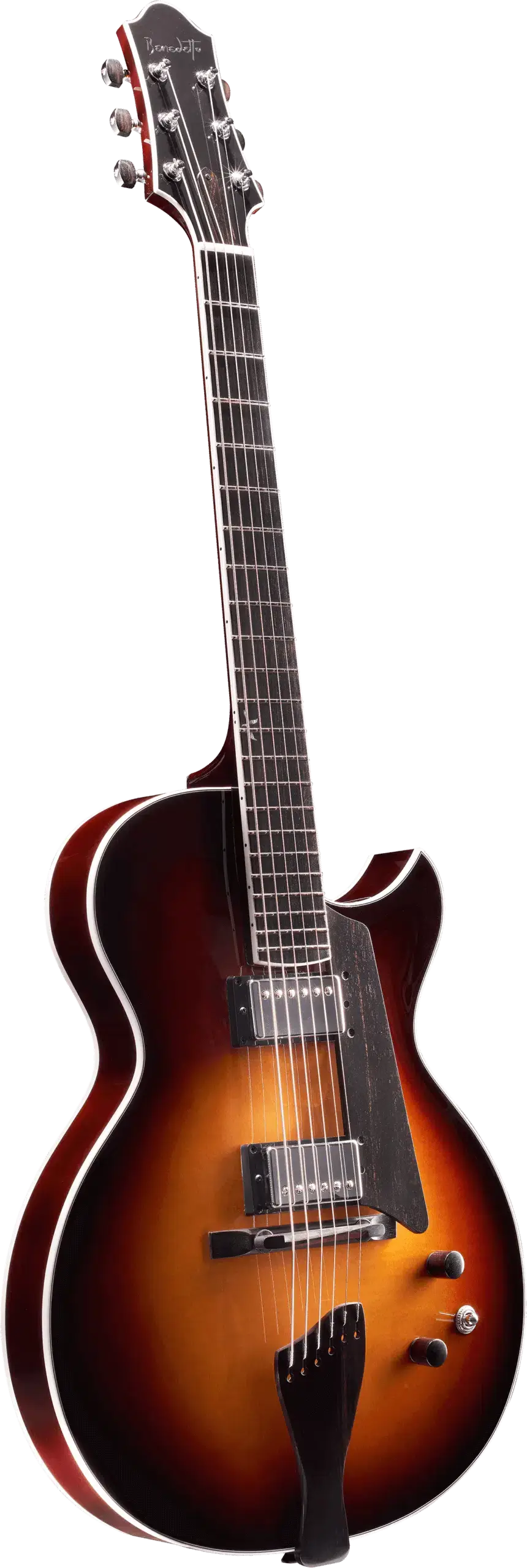
Why it’s special
Benedetto guitars, crafted by master luthier Robert Benedetto, are considered among the finest modern jazz guitars. The Bambino is a more compact archtop (its name means “baby”), designed to be travel-friendly and gig-ready without sacrificing tone. Jazz greats like Pat Martino and Howard Alden have favored Benedetto guitars, and the Bambino carries that pedigree with a smaller footprint.
In action
Don’t let its smaller size fool you – the Bambino delivers a full archtop sound. Its notes are clear and “woody,” and it’s feedback-resistant enough to handle higher volumes, which is great if you play in a live band. The fast neck and ergonomic body make it comfortable for long sessions. If you’re playing at a smaller club or just want something easier on the shoulders, the Bambino shines.
Great for
Intermediate to advanced players who gig frequently will love the balance of portability and pro-level tone. It’s also a hit with collectors of modern luthiery, as Benedetto instruments are meticulously made. While not cheap, you get what you pay for in quality. For those looking for a similar small archtop vibe on a budget, you might consider instruments like the Eastman AR380 (inspired by the Benedetto), but the Bambino itself is the real deal if you can swing it.
5. Gibson Super 400 – Big Body, Big Tone
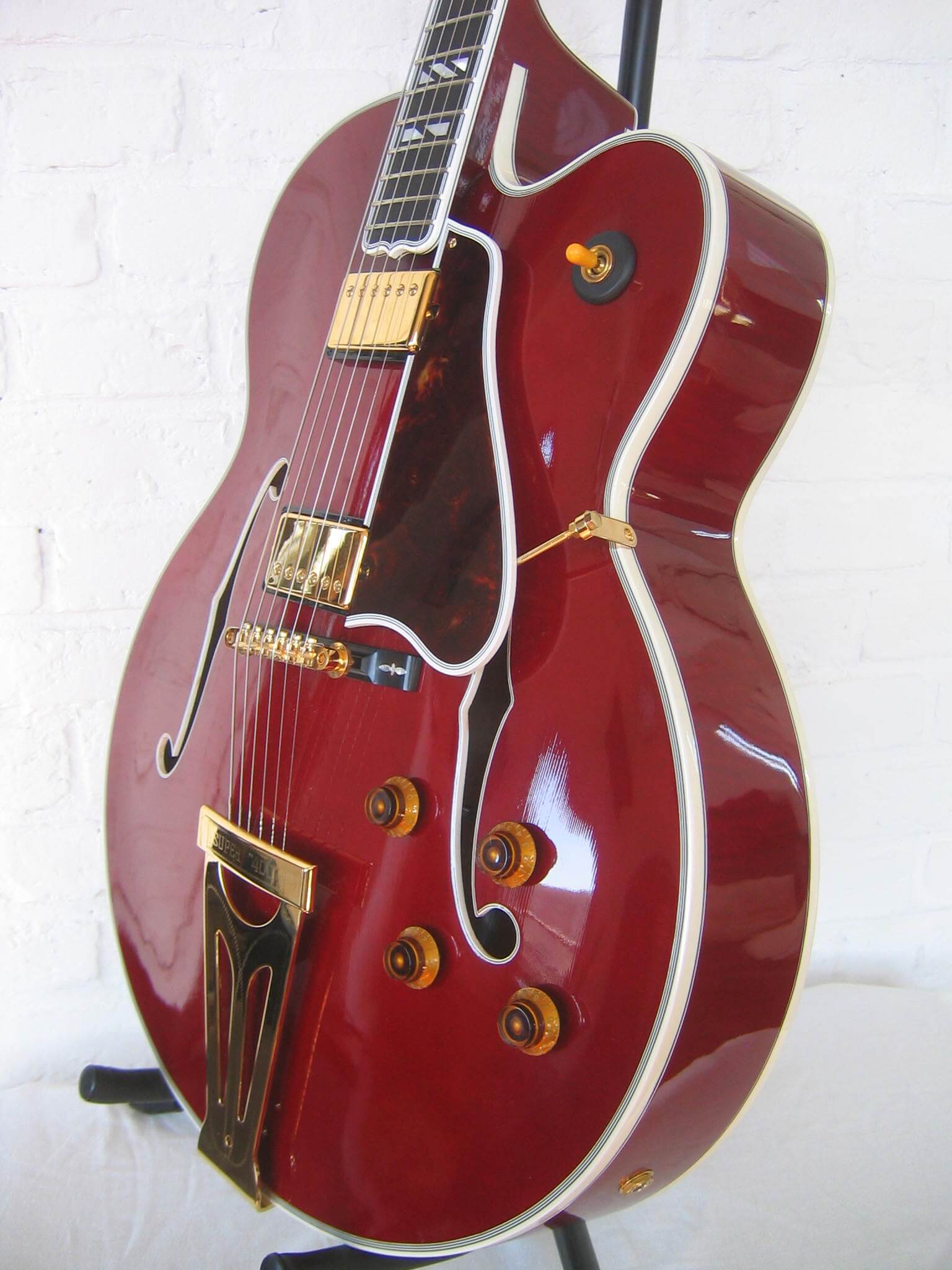
Why it’s iconic
The Super 400, first introduced in the 1930s, is Gibson’s largest traditional archtop jazz guitar. It earned its name from its initial $400 price tag back in the day (an exorbitant sum at the time). This guitar has an 18-inch wide body, which means huge, resonant sound. Jazz legends such as Herb Ellis and Barney Kessel have wielded Super 400s, enjoying the bold tone and volume it produces.
In action
When you play a Super 400, it’s almost like holding a small acoustic bass – the body is that large. Consequently, unplugged it has a thunderous acoustic voice. Plugged in, it’s warm and fat; single notes on a Super 400 feel almost like you’re playing a horn – they’re that thick. This guitar can drive a big band or fill a room with sound easily. Chord comping has a piano-like chunkiness.
Great for
The Super 400 is a dream for traditional jazz aficionados and collectors of vintage Gibsons. Intermediate players might not gravitate to something so large and expensive until later, but it’s worth knowing about this “holy grail” jazz box. If you ever find yourself needing maximum archtop volume and vibe (or see one in a shop), give it a try – it’s a piece of living history. Just be aware, the size can be a handful if you’re used to smaller guitars!
6. Fender Telecaster – The Unexpected Jazz Hero

Why it’s noteworthy
Wait – a Telecaster for jazz? Yes indeed. The Fender Telecaster, a solid-body guitar born for country and rock, has also found a loyal following in the jazz world. Players like Ted Greene, Ed Bickert, and modern masters like Tim Lerch have shown that a Tele can deliver superb jazz tones. With a warm neck pickup (often swapped for a humbucker or a darker single-coil), a Telecaster can surprise you in a jazz setting.
In action
The Telecaster’s allure in jazz is its clarity. Chords are crisp and well-defined, and single-note lines are articulate. Because it’s a solid-body, the Tele handles amplification and pedals without feedback – so you can even explore jazz fusion or other genres on the side. It might not have the hollow-body “air” of an archtop, but it makes up for it with sustain and versatility. If you listen to Ed Bickert’s recordings, you’ll hear a mellow, subdued tone that you’d swear came from a big jazz box – it’s actually a Tele.
Great for
Intermediate jazz players on a budget often already have a solid-body electric (like a Tele or Strat). The good news is you can get great jazz sound out of it by using flatwound strings and dialing back the tone knob. The Telecaster is great for those who want an all-around guitar – one that can handle jazz band practice in the afternoon and a rock gig at night. Plus, even collectors appreciate a Tele because it’s a piece of Fender history and an example of thinking outside the box for jazz.
7. Gibson Byrdland – Innovation in Design
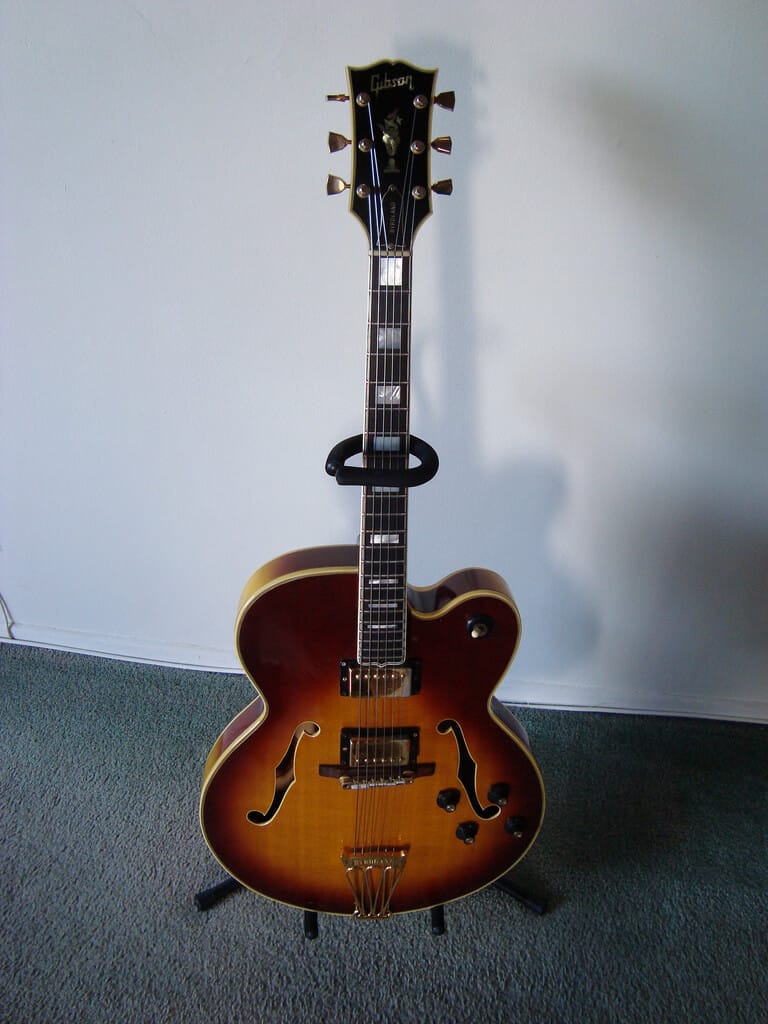
Why it’s iconic
The Byrdland was born in the 1950s out of a collaboration between guitarist Billy Byrd and Hank Garland (hence the name). Essentially, Gibson took a big archtop (the L-5) and gave it a thinner body and a shorter scale neck. The result was a high-end jazz guitar that’s easier to handle and allows for intricate chord voicings (thanks to the short scale allowing easier stretches). It still retains that L-5 DNA of superb craftsmanship. Herb Ellis and Jim Hall are among the notable players who spent time with a Byrdland in their hands
In action
Playing a Byrdland feels a bit different due to the short scale – you can execute wide interval chords that might be strenuous on a regular guitar. The tone is golden: warm, with a bit of that quick attack from the shorter scale. The slim body reduces feedback and is more comfortable, especially if you find big archtops unwieldy. It shines for chord-melody style playing and fast single-note runs alike.
Great for
If you love the idea of a Gibson L-5 but wish it were more compact, the Byrdland is your guitar. Intermediate players might find the fretboard easier if they have smaller hands or want to explore advanced chord shapes. It is, however, an expensive instrument given its flagship status. For a more attainable taste of this concept, one could look at a Gibson ES-175 (which has a similar scale length) or some of the Epiphone models, but the Byrdland itself remains a gem for those who can invest in a top-tier jazz guitar that marries big tone with a slim design.
8. Gretsch White Falcon – Flashy Looks, Bold Sound
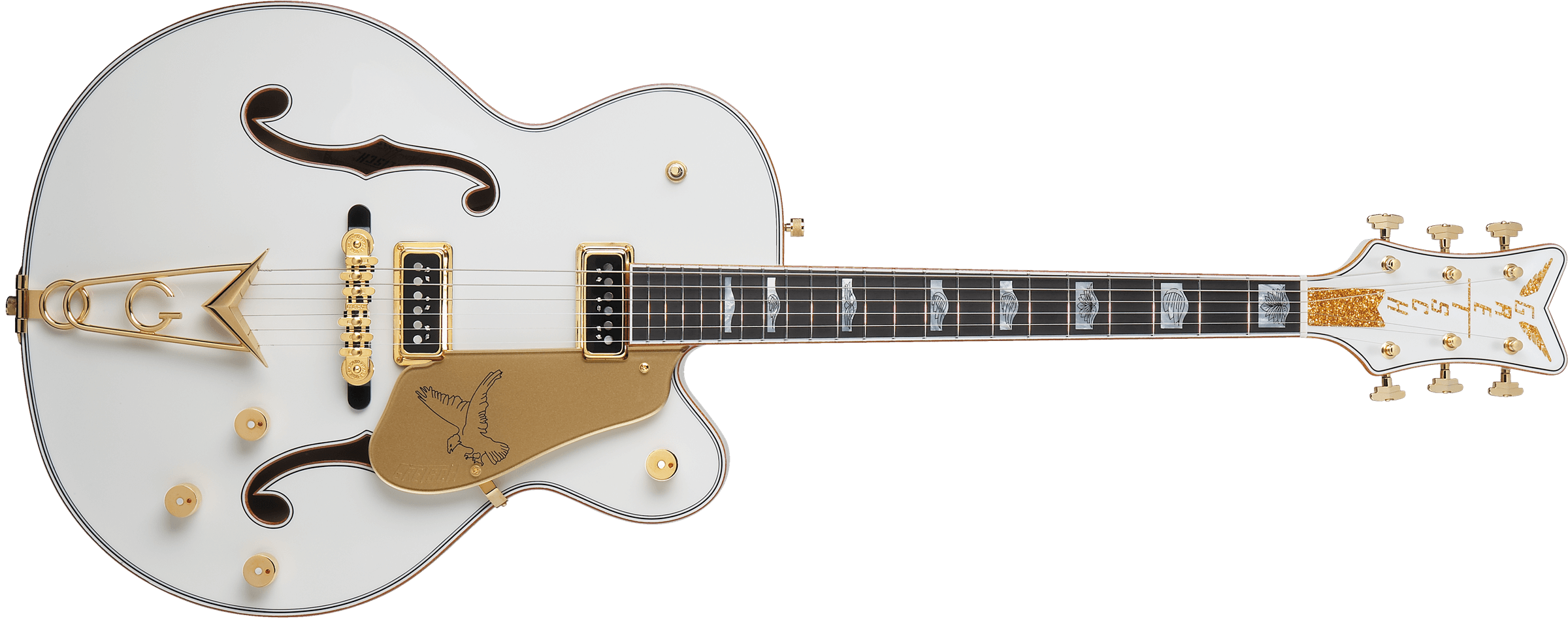
Why it’s iconic
The Gretsch White Falcon is an outlier on this list – it’s visually stunning (large white hollow body with gold trim and falcon motifs) and is often associated with rockabilly (think Brian Setzer) or even rock (Neil Young’s use). However, it’s also been used in jazz contexts by players like Brian Setzer (in his big band jazz mode) and even by prog/jazz fusion players like Steve Howe. It’s a full-bodied hollow guitar with twin pickups and a distinctive twangy-yet-warm Gretsch tone.
In action
The Falcon commands attention. Its tone is big and open; it doesn’t have the ultra-dark sound of a Gibson archtop – instead, it’s a bit brighter with a chime on the high end, yet still plenty warm on the neck pickup. In a jazz big band setting, those power chords and melody lines can cut through nicely. If you roll the tone down, you can get a smooth comping sound too. Plus, let’s be honest, when you walk on stage with a White Falcon, all eyes are on you – it’s just a cool guitar that starts conversations.
Great for
This guitar appeals to the showman and the collector alike. As an intermediate jazz player, a Gretsch Falcon might not be your first choice (and it’s definitely not a budget instrument), but it could be perfect for someone who straddles genres or wants a singular instrument that stands out. Also, if you play in a variety of styles (jazz, rockabilly, blues), a Gretsch can cover a lot of ground. There are more affordable Gretsch models that carry some of the Falcon’s vibe (look at the Electromatic series) if you love the concept but not the price tag.
9. Ibanez George Benson Signature (GB series) – Modern Smoothness

Why it’s notable
Ibanez has a strong reputation for making quality jazz guitars at more affordable prices, and their relationship with jazz guitar legend George Benson is the crown jewel of that effort. The GB10 and related models are George Benson’s signature guitars – compact hollow-bodies designed to his specifications. They have a slightly smaller body than a traditional Gibson, a fast neck, and custom pickups that deliver a clean, smooth tone. Players like Pat Metheny and Lee Ritenour have even been known to pick up Benson models or other Ibanez archtops for their reliability and sound.
In action
Plug in a GB10 and you’ll get a velvety jazz tone right away. The notes are balanced – not too dark, not too bright. The smaller body means it’s comfortable to hold for long gigs and less prone to feedback. George Benson himself uses it to play everything from straight-ahead jazz to pop, and it never sounds out of place. One minute you can be comping Freddie Green-style, and the next you’re tearing into a bebop solo – the clarity and sustain are there.
Great for
Intermediate players love the Ibanez Artcore and Benson series because they provide a pro sound without the giant price tag of a Gibson. The GB models are higher-end within Ibanez’s line, but you truly get performance on par with top-tier guitars. If you’re serious about jazz but need something roadworthy and relatively affordable (especially second-hand), the Ibanez GB models are a fantastic option. Collectors also appreciate these guitars – early Japan-made Benson signatures have become collectible in their own right. It’s a perfect blend of vintage vibe and modern playability.
10. Epiphone Joe Pass Emperor II – Best Bang-for-Buck Jazz Box
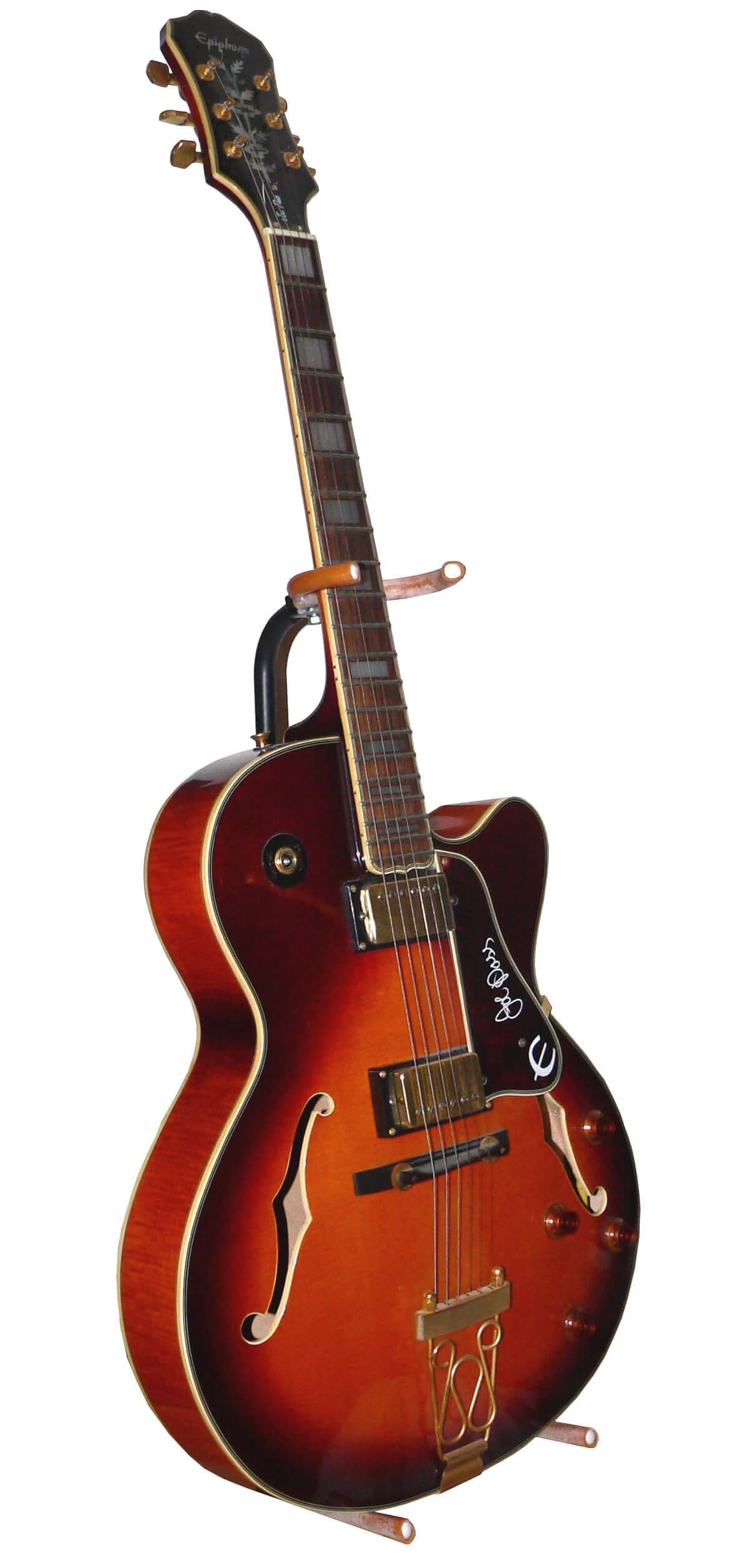
Why it’s notable
The Epiphone Emperor II is the signature model of the late, great Joe Pass – one of jazz guitar’s legends. Epiphone (the sister company of Gibson) created this model to be an accessible, affordable archtop that still delivers on tone. It’s a full-hollow guitar with classic looks and has been a go-to recommendation for jazz students and semi-pro players for years. Notably, players like Russell Malone and even Martin Taylor have been associated with using this model, showing that it can perform on stage and in recordings despite its lower price tag.
In action
The Emperor II produces a sweet, warm tone ideal for jazz standards. Chords have that chunky “Freddie Green” sound and solos have a singing quality, especially with the tone knob rolled off a touch. It’s not quite as polished or rich as a $3000 Gibson, but in a blind listening test, many would be hard-pressed to tell the difference. Joe Pass himself proved you can play world-class jazz on an Epiphone just fine. This guitar also typically comes with comfortable low action setup, which makes it easier for intermediate players to develop their technique.
Great for:
This is the guitar we often suggest to intermediate jazz guitarists on a budget. If you’re looking for one of the best jazz guitars without breaking the bank, the Epiphone Joe Pass Emperor II should be on your list. It’s also a nice backup or alternate guitar for a pro who doesn’t want to bring a prized vintage axe to the gig. Collectors might not covet it the way they do a Gibson, but they’ll acknowledge it as a practical piece of gear that honors a legend and delivers solid performance. In terms of bang for your buck, the Emperor II is hard to beat in the jazz world.
Conclusion
Jazz guitars come in all shapes and sizes – and as we’ve seen, “best” can mean different things for different players. From the golden-era archtops like the Gibson ES-175 and L-5 that defined jazz history, to modern workhorses like the Ibanez GB series and the budget-friendly Epiphone Emperor II, each guitar on this list earns its spot for a reason. If you’re an intermediate jazz player, hopefully this rundown gives you a sense of what’s out there, from aspirational high-end instruments to realistic options you can save up for. If you’re a collector, these models are classics that carry stories of jazz lore.
In the end, the best jazz guitar is the one that inspires you to play more. So whether you’re comping through a ** ii-V-I ** progression on a big hollow-body or jamming at home on your trusty Tele, the key is that it suits your style and makes you happy. Try out as many guitars as you can, listen to your heroes for guidance, and you’ll find the guitar that makes you fall in love with jazz all over again. Happy playing, and may your tone be ever smooth!
